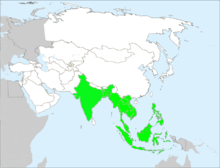Reticulated python
| Reticulated python | |
|---|---|
 |
|
|
Not evaluated (IUCN 3.1)
|
|
| Scientific classification | |
| Kingdom: | Animalia |
| Phylum: | Chordata |
| Class: | Reptilia |
| Order: | Squamata |
| Suborder: | Serpentes |
| Family: | Pythonidae |
| Genus: | Python |
| Species: | P. reticulatus |
| Binomial name | |
|
Python reticulatus (Schneider, 1801) |
|
 |
|
| Synonyms | |
|
|
The reticulated python (Python reticulatus) is a species of python found in Southeast Asia. They are the world's longest snakes and longest reptiles and among the three heaviest snakes. Like all pythons, they are nonvenomous constrictors and normally not considered dangerous to humans. Although large specimens are powerful enough to kill an adult human, attacks are only occasionally reported.
An excellent swimmer, P. reticulatus has been reported far out at sea and has colonized many small islands within its range. The specific name, reticulatus, is Latin meaning "net-like", or , and is a reference to the complex color pattern.
This species is the largest snake native to Asia. More than a thousand wild reticulated pythons in southern Sumatra were studied and estimated to have a length range of 1.5 to 6.5 m (4.9 to 21.3 ft) and a weight range of 1 to 75 kg (2.2 to 165.3 lb). Reticulated pythons with lengths more than 6 m (19.7 ft) are rare, though according to the Guinness Book of World Records, it is the only extant snake to regularly exceed that length. A reticulated python of the same length as a green anaconda may weigh only half as much as the bulkier anaconda. One of the largest scientifically measured specimens, from Balikpapan, East Kalimantan, Indonesia, was measured under anesthesia at 6.95 m (22.8 ft) and weighed 59 kg (130 lb) after not having eaten for nearly 3 months. Widely published data of specimens that were reported to be several feet longer have not been confirmed.
The specimen once widely accepted as the largest-ever "accurately" measured snake, that being Colossus, a specimen kept at the Highland Park Zoo (now the Pittsburgh Zoo and PPG Aquarium) in Pittsburgh, Pennsylvania, during the 1950s and early 1960s, with a peak reported length of 8.7 metres (28 ft 7 in) from a measurement in November 1956, was later shown to have been substantially shorter than previously reported. When Colossus died on April 14, 1963, its body was deposited in the Carnegie Museum of Natural History. At that time, its skeleton was measured and found to be 20 ft 10 in (6.35 m) in total length, and the length of its fresh hide was measured as 23 ft 11 in (7.29 m) – both measurements being significantly shorter than what had been previously estimated in 1956. The hide tends to stretch from the skinning process, and thus be longer than the snake from which it came – e.g., by roughly 20–40% or more. The previous reports had been constructed by combining partial measurements with estimations to compensate for "kinks", since it is virtually impossible to completely straighten an extremely large live python. Because of these issues, a 2012 journal article concluded that "Colossus was neither the longest snake nor the heaviest snake ever maintained in captivity." Too large to be preserved with formaldehyde and then stored in alcohol, the specimen was instead prepared as a disarticulated skeleton. The hide was sent to a laboratory to be tanned, but it was either lost or destroyed, and now only the skull and selected vertebrae and ribs remain in the museum's collection. There is considerable confusion in the literature over whether Colossus was male or female (females tend to be larger).
...
Wikipedia
